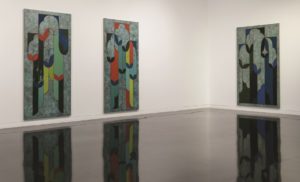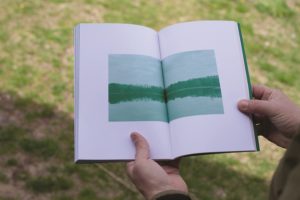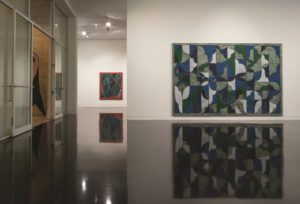Iran and Wellfleet are worlds apart, yet the painter Kamrooz Aram managed to find memories of his native country in the reflections of Wellfleet’s kettle ponds on two visits to the Outer Cape in the past year. “When the pond is still and the trees are reaching down and also reaching up, I’m reminded of palaces in Iran with reflecting pools,” he explains from his studio in Brooklyn, referencing the architectural wonder Chehel Sotoun in Isfahan, Iran, with its large pool reflecting the building’s 20 columns.

In preparing for his current exhibition at the Arts Club of Chicago, on view until Aug. 13, Aram was initially dismayed by the glossy reflective surface of the gallery floors. “This is a problem,” he recalls thinking, yet particular to his practice is a tendency “to work with the architecture rather than against it.” Eventually, he came to embrace the surface, hanging large paintings, many with a vertical orientation, close to the floor to maximize the opportunity for their reflection.
“The paintings are site specific,” Aram says. Three large vertical paintings were “made for that location” to feel “part architectural and part organic, referencing both the reflections in the ponds and in the palace pools.” In these paintings, he works with the structure of the grid, organizing it to emphasize three columns, fluctuating in height and cut through with stylized leaf shapes. The compositions are sparse, with an active interplay between negative and positive space. Subdued blues and greens dominate, suggesting the Cape landscape.

Accompanying the exhibition, Aram produced Privacy, A Notebook, which serves to “explore the things that hover around the work.”
“This exhibition and this notebook are the most private thing for the public and the most vulnerable I’ve made myself,” Aram says. In the text, a series of loosely connected photographs and dated entries, he charts the way his mind moves between concerns as varied as temporary rentals, compositional decisions for his paintings, and his mother’s death. Themes, many of which he locates in Wellfleet, gradually emerge, including the legacy of modernism and the division between public and private spaces.
Aram, who emigrated from Iran to the U.S. at age eight, has spent most of his career in New York. His first awareness of Cape Cod was as the name of a cocktail, but he started visiting on a regular basis when friends from graduate school, ICA/Boston chief curator Eva Respini and artist-designer Jacob Dyrenforth, bought a place in Wellfleet. He stayed at their home in August and December 2021 and found the mental space to plan his current show in Chicago.
“I found that when I was in the city, I was constantly under the stress of something that was outside of the studio and that stuff starts to occupy your mind,” he says. “In Wellfleet, just going for a hike or walking on the beach, your mind starts clearing up and ideas started coming to me much quicker than I had really ever experienced.”
In Privacy, A Notebook, Aram writes: “In Wellfleet I encounter a natural space that is neither social nor private. Perhaps it is public in a broad sense, but is a space that functions on the periphery of society altogether considered to be public?”

This peculiarity of the Cape Cod National Seashore reverberates in memories of his mother’s childhood home and reflections on domestic Iranian architecture, with its division of public and private quarters and their gardens as “transitional spaces.” With his exhibition on the horizon, these musings raised concerns about the Arts Club of Chicago as a “private club with a public exhibition space,” resulting in the eventual creation and installation of work addressing tensions between public and intimate spaces, perhaps best illustrated in a sheer screen he installed in one of the galleries, partitioning a space as inaccessible yet revealing its content — an intimate porcelain bust.
During Aram’s Wellfleet stay last winter he became aware of how private property demarcations, so pronounced in summer, loosen up in the off season. In the summer, he paddled into Williams Pond to “find an unsatisfactory glimpse of Marcel Breuer’s Wellfleet home”; in December, he writes, “I have granted myself the privilege of circumambulating three Breuer homes, shuttered for the winter, all of them exquisite in their unremarkable condition.”

In his text, he includes his own photographs of Wellfleet’s modernist summer houses. “I kind of fetishize those forms,” he says, though his admiration isn’t uncritical. “I want to challenge the discourse that created this kind of hierarchy, that set ornament into something that’s for less sophisticated cultures. While I set out to renegotiate that history in my work, I am also really attracted to modernist form. That’s one of the contradictions that I embody as a person and in my work.”
His paintings expose these dueling interests, between Eastern and Western visual histories and between reductive and decorative abstraction.
One modernist preference he can get behind is a love for Wellfleet. “What resonates with me is the fact that Breuer found Wellfleet to be this very special place on Earth,” Aram says. “It was interesting to see the inspiration that Breuer found there, and I can feel the sense that it opens you up in a way.”



